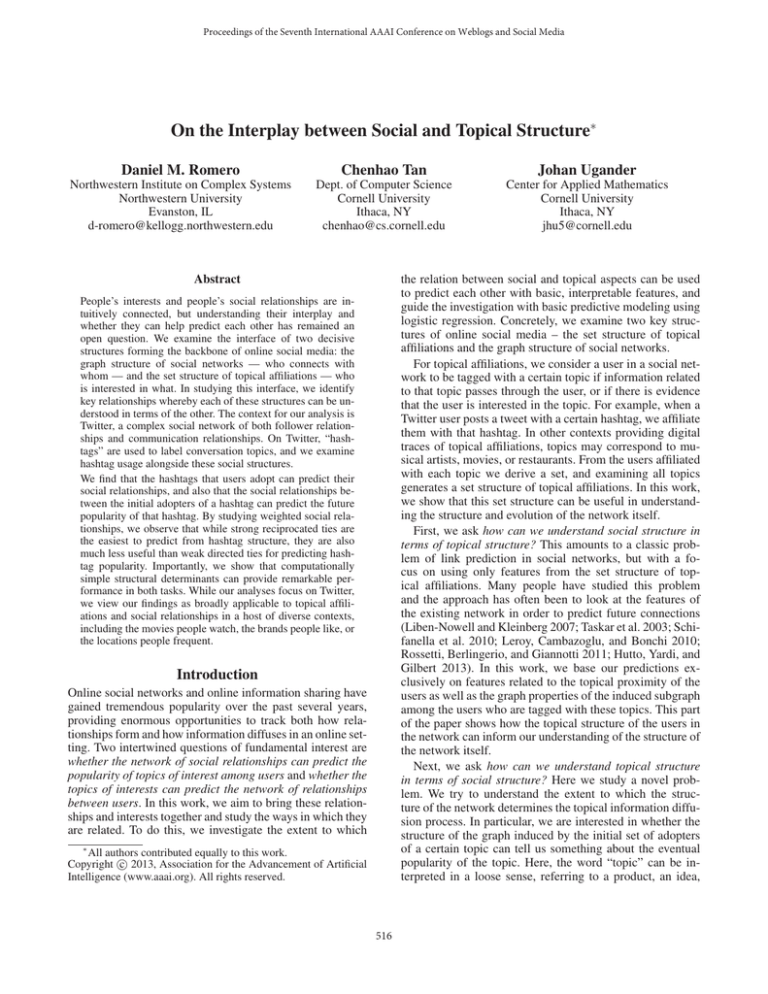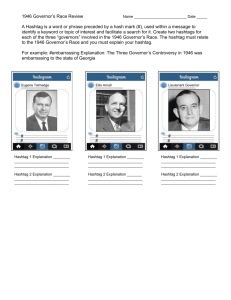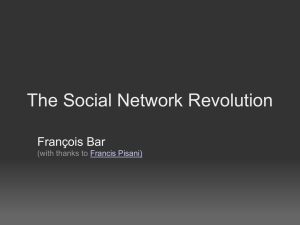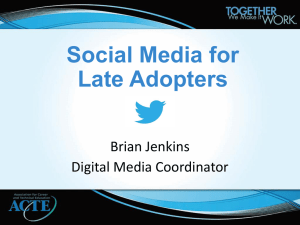
Proceedings of the Seventh International AAAI Conference on Weblogs and Social Media
On the Interplay between Social and Topical Structure∗
Daniel M. Romero
Chenhao Tan
Johan Ugander
Northwestern Institute on Complex Systems
Northwestern University
Evanston, IL
d-romero@kellogg.northwestern.edu
Dept. of Computer Science
Cornell University
Ithaca, NY
chenhao@cs.cornell.edu
Center for Applied Mathematics
Cornell University
Ithaca, NY
jhu5@cornell.edu
Abstract
the relation between social and topical aspects can be used
to predict each other with basic, interpretable features, and
guide the investigation with basic predictive modeling using
logistic regression. Concretely, we examine two key structures of online social media – the set structure of topical
affiliations and the graph structure of social networks.
For topical affiliations, we consider a user in a social network to be tagged with a certain topic if information related
to that topic passes through the user, or if there is evidence
that the user is interested in the topic. For example, when a
Twitter user posts a tweet with a certain hashtag, we affiliate
them with that hashtag. In other contexts providing digital
traces of topical affiliations, topics may correspond to musical artists, movies, or restaurants. From the users affiliated
with each topic we derive a set, and examining all topics
generates a set structure of topical affiliations. In this work,
we show that this set structure can be useful in understanding the structure and evolution of the network itself.
First, we ask how can we understand social structure in
terms of topical structure? This amounts to a classic problem of link prediction in social networks, but with a focus on using only features from the set structure of topical affiliations. Many people have studied this problem
and the approach has often been to look at the features of
the existing network in order to predict future connections
(Liben-Nowell and Kleinberg 2007; Taskar et al. 2003; Schifanella et al. 2010; Leroy, Cambazoglu, and Bonchi 2010;
Rossetti, Berlingerio, and Giannotti 2011; Hutto, Yardi, and
Gilbert 2013). In this work, we base our predictions exclusively on features related to the topical proximity of the
users as well as the graph properties of the induced subgraph
among the users who are tagged with these topics. This part
of the paper shows how the topical structure of the users in
the network can inform our understanding of the structure of
the network itself.
Next, we ask how can we understand topical structure
in terms of social structure? Here we study a novel problem. We try to understand the extent to which the structure of the network determines the topical information diffusion process. In particular, we are interested in whether the
structure of the graph induced by the initial set of adopters
of a certain topic can tell us something about the eventual
popularity of the topic. Here, the word “topic” can be interpreted in a loose sense, referring to a product, an idea,
People’s interests and people’s social relationships are intuitively connected, but understanding their interplay and
whether they can help predict each other has remained an
open question. We examine the interface of two decisive
structures forming the backbone of online social media: the
graph structure of social networks — who connects with
whom — and the set structure of topical affiliations — who
is interested in what. In studying this interface, we identify
key relationships whereby each of these structures can be understood in terms of the other. The context for our analysis is
Twitter, a complex social network of both follower relationships and communication relationships. On Twitter, “hashtags” are used to label conversation topics, and we examine
hashtag usage alongside these social structures.
We find that the hashtags that users adopt can predict their
social relationships, and also that the social relationships between the initial adopters of a hashtag can predict the future
popularity of that hashtag. By studying weighted social relationships, we observe that while strong reciprocated ties are
the easiest to predict from hashtag structure, they are also
much less useful than weak directed ties for predicting hashtag popularity. Importantly, we show that computationally
simple structural determinants can provide remarkable performance in both tasks. While our analyses focus on Twitter,
we view our findings as broadly applicable to topical affiliations and social relationships in a host of diverse contexts,
including the movies people watch, the brands people like, or
the locations people frequent.
Introduction
Online social networks and online information sharing have
gained tremendous popularity over the past several years,
providing enormous opportunities to track both how relationships form and how information diffuses in an online setting. Two intertwined questions of fundamental interest are
whether the network of social relationships can predict the
popularity of topics of interest among users and whether the
topics of interests can predict the network of relationships
between users. In this work, we aim to bring these relationships and interests together and study the ways in which they
are related. To do this, we investigate the extent to which
∗
All authors contributed equally to this work.
c 2013, Association for the Advancement of Artificial
Copyright Intelligence (www.aaai.org). All rights reserved.
516
Dataset
or even a behavior. The idea that the speed and magnitude of adoption of products, ideas, and behaviors can be
driven by “viral marketing” techniques has gained tremendous popularity over the past few years (Brown and Reingen
1987; Goldenberg, Libai, and Muller 2001; Richardson and
Domingos 2002; Leskovec, Adamic, and Huberman 2007;
Rogers 1995; Gruhl et al. 2004; Kimura and Saito 2006;
Tsur and Rappoport 2012). The premise is that one can utilize the edges of an existing social network as bridges for
information to spread from person to person. A common
challenge is how to maximize the spread of a topic. The
focus of our study is to ask: how is this growth related to
nascent graph structure? To shed light on this question, we
test a predictive algorithm that takes properties of the induced subgraph of the early adopters of a topic as features,
with the goal of predicting its eventual popularity.
The dataset used in this paper consists of two main parts:
hashtags and networks. During January 2010, Twitter was
crawled using their publicly available API. The last 3,200
tweets of each existing user were collected. Over 95% of the
users in this dataset have less than 3,200 tweets. Hence, the
dataset contains a complete history of tweets for almost all
users. Overall, over three billion messages from more than
60 million users were obtained during this crawl (Romero,
Meeder, and Kleinberg 2011).
Hashtags. A convention widely used by Twitter users is a
tagging system where a user includes a single undelimited
string proceeded by a “#” character. This string is termed a
hashtag, and it is meant to label the tweet in order to signal
to others that it belongs to a particular conversation topic.
For example: “What a thrilling game last night between
the Thunder and Grizzlies. #NBA.” From our dataset we
extracted a total of 7,305,414 hashtags, with 5,513,587
users who utilized at least one hashtag. On average, each
hashtag was used by 9.48 distinct users, while a user posted
about 12.57 different hashtags.
Our particular domain of study is Twitter. We use hashtags — labels that users include in their posts to indicate
the topic of the message — to distinguish between different
topics. As for social relationships, we consider both the follower and @-message communication networks as proxies
for social connections among the users. Because these networks are directed and the @-message network is weighted,
we are able to compare the differences in our results when
considering strong and weak ties, as well as reciprocated and
unreciprocated relationships.
Graphs. We obtained the follower/followee graph from
(Kwak et al. 2010), which contained the list of people each
person was following at crawl time. If user A follows user
B we create the edge (A, B). There are around 366 million edges among the users who have utilized at least one
hashtag. The second graph is based on @-messages. These
are posts that are publicly directed from one user to another.
They can be used as directed messages, or to reference another user. To send an @-message, the sending user includes
the “@” character next to the receiving person’s username
in their tweet. The @-graph is created by constructing the
edge (A, B) if A has sent at least n @-messages to B in
the tweets available (n is a threshold to indicate the strength
of the relationship between two users). There are around 85
million edges in the @-graph with threshold n = 1 among
the users who have utilized at least one hashtag.
Contributions. First, we demonstrate how merely basic features from topical affiliations can yield remarkable prediction accuracy in link prediction. The performance can be
further improved by incorporating social graph properties of
these topics. Second, we find that the structure of the subgraphs induced by early adopters can indeed have predictive
power about the eventual popularity of the topic. Furthermore, we observe that the relationship between the topological properties of the initial graphs and the topic’s popularity is not always straight forward. For example, popularity
of a topic does not monotonically change with the number of social connections among the initial users. Instead,
we find that the topic gains popularity specifically when the
number of connections is either very high or very low. This
could come as a surprise since few connections among initial adopters of a topic could be perceived as the topic lacking “virality.” Bridging these two findings, we discover that
while strong reciprocated ties are the easiest to predict from
hashtag structure, they are also much less useful than weak
directed ties for predicting hashtag popularity. Our hypotheses for possibly explaining these observations are also discussed.
Social Structure from Topical Structure
In this section, we investigate the social structure from the
topical affiliation system defined by the usage of hashtags.
Specifically, we ask to what extent a user’s hashtags reveal
their ties to other users in Twitter’s directed follower graph,
or their ties to other users via @-messages. By allowing
hashtags to define user sets, we can view Twitter users as
embedded in the topical affiliation system of these hashtags.
We focus on the features extracted from the topical affiliations in the hope that this topical affiliation system helps us
understand the social structure. We consider the link prediction problem, where we are trying to predict the presence
of an edge between arbitrary pairs of individuals. From this,
we observe that the popularity of the least popular common
hashtag that two users overlap on is a surprisingly informative predictor. Having observed this, we demonstrate that
adding simple features of the graph structure of these least
popular common hashtags can be used to develop a capable
predictive model.
Throughout this work we use naive baselines to compare
with our prediction results. The reason for that is that we do
not aim to present sophisticated algorithms and techniques
that explicitly maximize the accuracy of link and popularity
prediction. We instead aim to expose the relationship that
topical structure and social structure share by showing that
simple features of topical affiliations can predict social relationships and that simple features of social structure can
predict topical popularity, even through standard predictive
models.
517
1e−06
1e−04
1e−02
Empirical
a=1.076 (fit)
a=1.000
1e−08
Pr( @ edge | distance )
1e−02
1e−04
Pr( follow edge | distance )
Empirical
a=0.884 (fit)
a=1.000
1e−06
Measuring topic distance. In order to approach this question, we must first summarize the hashtag usage similarity of
two individuals from the topical affiliation system into features that could plausibly serve as similarity/distance measures. Perhaps the most obvious measure of similarity is the
number of sets that contain two users. In our context this
corresponds to the number of hashtags that two users have
in common. This measure is immediately problematic, since
it does not distinguish between hashtags that are broadly
adopted and those that have only been used by a handful of
users. To address this issue, we define the size of a hashtag
to be the number of people who have used the hashtag, and
consider features that relate to the size of the common hashtags. For this, we consider the size of the smallest common
hashtag, the size of the largest common hashtag, the average size, and also two measures that aggregate the common
overlap of the full sets: the sum distance and the AdamicAdar distance (Adamic and Adar 2003).
Consider the following notation:
• Let u1 , . . . , uN be the N users.
• Let h1 , . . . , hM be the M hashtags.
• Let H(ui ) be the set of hashtags used by users ui .
• Let U (hj ) be the users who used hashtag hj .
The features of the common hashtags between users that
we consider in the work are:
• The number of hashtags in common,
|H(ui ) ∩ H(uj )|.
• The size of the smallest common hashtag,
minh∈H(u)∩H(v) |U (h)|.
• The size of the largest common hashtag,
maxh∈H(u)∩H(v) |U (h)|.
• The average P
size of the common hashtags,
1
h∈H(u)∩H(v) |U (h)|.
|H(u)∩H(v)|
• The
sum
of
the
inverse sizes,
P
h∈H(u)∩H(v) 1/|U (h)|.
• The
P Adamic-Adar distance,
h∈H(u)∩H(v) 1/ log |U (h)|.
1e+01
1e+03
1e+05
1e+07
Smallest common hashtag distance
1e+01
1e+03
1e+05
1e+07
Smallest common hashtag distance
Figure 1: Linkage probability as a function of smallest common hashtag. (a) The probability of a given user following
another user as a function of the size, and (b) the probability
of a given user @-messaging another user as a function of
size. Both figures are shown on a log-log scale.
The size of the largest common hashtag is an intuitively
poor feature for predicting links, and we include it here
specifically as a dummy feature, showing that not all
features of the common hashtags are informative. Very
commonly, the largest common hashtag that users overlap
on is one of a few extremely popular hashtags, for example,
#musicmonday, #ff, or #fail. In choosing to study the
sum distance and Adamic-Adar distance — a measure
introduced for studying the similarity of web-based social
networks derived from common homepage content — we
allow ourselves to consider similarity measures using all
common hashtags (topics).
Predictive model. Given the features defined above, we now
investigate how well the topical overlap represented in the
common hashtags allows us to predict the presence of links.
We formulate this task as a balanced classification task:
given a random set of 100,000 user pairs that coincide on
at least one hashtag,1 where 50,000 are disconnected pairs
and 50,000 are connected, what sort of prediction accuracy
can we obtain, compared to a naive 50% baseline?
We approach the problem using logistic regression with
10-fold cross-validation. For all six features, in addition to a
linear term, we also include the logarithm and the inverse of
each value, allowing us to more robustly extract non-linear
dependencies.
We consider the tasks of predicting follow edges, mutual
follow edges, @-message edges, and mutual @-message
edges. It is natural to view the number of @-messages as the
strength of a tie, and we therefore also consider our classifi-
The size of the smallest common hashtag is an intuitively
attractive measure since it captures the extent to which the
conversations two persons share are unique or not. It also
happens to have a significance in the study of decentralized
information routing. In (Kleinberg 2002), Kleinberg studied
social networks where individuals were viewed as embedded in a set system (much like this hashtag topical affiliation system) and an individual u was linked to an individual
v with probability proportional to d(u, v)−a , where d(u, v)
is the size of the smallest common set. Kleinberg showed
that decentralized greedy routing with regard to this measure takes polylogarithmic time if and only if a = 1. We
observe that this dependence between smallest common size
and link probability approximately holds true in our setting.
From Figure 1 we see that the probability of a link as a function of the smallest common hashtag size appears to obey an
inverse power law. In the case of @-communication (here
thresholded on 3 @-messages), the probability of linkage
appears to be quite close to a = 1, the condition for efficient
decentralized greedy routing.
1
We consider only user pairs that coincide on at least one hashtag because performing classification against completely arbitrary
user pairs (where only 4.9% of hashtag-using user pairs coincide
on some hashtag) would have been overly generous to our classifier. Arbitrary users rarely coincide on any hashtags, and the coincidence rates between connected users is understandably going to be
higher. In fact, 35% of user pairs where one user follows the other
coincide on some hashtag, and fully 78% coincide when comparing user pairs where one person has @-messaged the other person
at least once.
518
5e+05
cation task applied to @-message edges thresholded on different @-message counts. Note that for each of the tasks, we
use a sample of 100,000 user pairs that coincide on at least
one hashtag where half of the pairs are connected and half
disconnected according to the particular definition of edges
in the task.2 Therefore the naive baseline is 50% for all the
different tasks. The accuracies we obtain are shown in Table 1, where we report the performance of both a full model,
considering all features under all transformations, and also
models trained on a single feature set (where we include its
two transformations).
We see that classification based on common hashtag
usage exhibits powerful prediction accuracy given its simplicity: for follow edges our accuracy is 74%, for @-edges
it is 83%, and for strong @-edges (more than 20 messages),
our accuracy is 87%. We achieve comparable performance
when predicting mutual edge relationships. Beyond this
general performance, we note that the size of the smallest
common hashtag is a consistently accurate feature when
considered alone, especially when trying to predict strong
ties. As expected, the size of the largest common hashtag is
least informative.
ff
musicmonday
2e+05
fb
fail
tinychat
5e+04
1e+05
nowplaying
2e+04
Number of individuals using the hashtag
twibbon
iranelection
beatcancer
iphonetwitter
fact
facebook
music s follow
red
moonfruit
quote
mm
googlewave
google
squarespace
apple
10yearsago michaeljackson
free
openwebawards
swineflu
tcot
twitition
mw2
lol
news
iwish 3wordsaftersex
whentwitterwasdown
obama socialmedia
cnnhootsuite
wtf
forasarney
glee
09memories
2010
livestrong
itunes
wave medo jobs
marketing
random
design
iran tech
tweetcloud
fato blogger
shazam
mj fixreplies
hc09
travel
love
t lost nfl
rio2016
healthcare
avatar
formspringme
green
why
photography
vmatenso
p2
truth
food
wordpress
health
video
art
hcr
m web
tweetdeck
quotes
youtube
balloonboy
i
notagoodlook
gmail
microsoft
trueblood
mac
fml
yankees
winmbp
h1n1
tvfunny business
helpiranelection
halloween
entrepreneur
firefox
twitterfail
n
politics
win
macheist
seo
christmas
twitdraw
epicfail
spymaster
media
f f1wwdc
mrtweet
sxsw
lastfm
welovethenhs
fashion
inturnoff
lameclaimtofame
xfactor
job
rip
humor
followers
blackberry
euri
ifsantawasblack
blogtalkradio
internet
rt teaparty
android
theoffice
gr88
oneletteroffmovies
tgif
iamblessed
neda
admitit
d
mafiawars itshouldbeillegal
m
ovies
startrek
wow
education
justsayin
geek
happy
twilight
awesome
webdesign
the
worldaidsday
help
lies
spam
windows7
football
linuxbing
chupa
uksnow
windows
uncharted2
social
nyc
fun
redsox
michael
twtpoll
pr
ipod
tehran
unfollow
3wordsduringsex
haveyouever
mussumday
zemayerfacts
tlot
cool
rejectprop8
somethingaintright
goodnight
photo
technology
deviantart
iamthankfulfor
tweetphoto
5e−06
2e−05
5e−05
2e−04
5e−04
2e−03
5e−03
Edge density
Figure 2: Edge density heterogeneity for the 200 most common hashtags in the dataset.
Predictive model with edges. The features we consider
above do not extract anything about the graph structure of
the induced subgraphs that each hashtag defines.3 Extending the high accuracy of models based solely on the size of
the smallest common hashtag, we now show that a simple
feature of the subgraph of the smallest common hashtags –
its edge density – can further improve our predictions.
One motivation for considering the graph structure is the
observation, shown in Figure 2, that the edge density for
similarly sized hashtags can differ considerably. Edge density for a hashtag is defined as the probability that two users,
who have utilized the hashtag, are connected.4 Figure 2
shows the density of each hashtag in the follower graph as a
function of the size of the hashtag. Using the @-graph produces a similar figure.
Simply put, some hashtags — some topics — are much
more “social” than others. For example, #teaparty and
#mafiawars have similar popularity, however, the users in
#teaparty are much more connected to each other, a plausible indicator that #teaparty is more “social.” In another context, where instead of hashtags we considered geographic
locations as topics, this would translate to knowing that two
people both visit a bar versus knowing that they both visit
the same bank. Both may be equally unpopular locations to
visit, but the bar is a decidedly more social environment, and
two people having visited the same bar is clearly going to
predict more social interaction than having visited the same
bank.
We would like to include the count of edges appearing
in the smallest common hashtag as a feature in our prediction tasks. However, it is important to avoid inadvertently
incorporating a circular reference whereby the link we are
trying to predict is directly present in this feature. For example, consider the problem of predicting an edge between
a pair of users where the induced subgraph for their smallest common hashtag has size two and one edge. If we don’t
make any correction, we would know for certain that these
two users are connected. We therefore let our edge count
feature be the number of edges present in the smallest common hashtag between users other than the two users being
considered.
By including the count of such edges appearing in the
smallest common hashtag as a feature, where the type of
the edges is the same as the type we are trying to predict, we
see that our classification performance becomes more accurate, demonstrating an accuracy of 76.6% when classifying
follower relationships and 97.6% when classifying strongly
tied @-edges. This improvement is consistent across all the
predictions tasks we consider.
Topical Structure from Social Structure
As we observed in the previous section, the topical affiliation structure of a social network is related to its social
structure and can be used to predict social links. In this
section, we aim to exploit the topical structure from the
characteristics of the network. Specifically in Twitter, we try
to predict the future popularity of hashtags with simple features of the graph induced by the initial adopters of hashtags.
2
Note that we have different sets of user pairs for different prediction tasks to keep the dataset balanced.
3
The induced subgraph from a hashtag refers to the edges between the users who have used that hashtag.
4
Formally, edge density for a hashtag is defined as
|{(u,v)∈E|u∈U (h),v∈U (h)}|
. E can be either the set of edges in the
|U (h)|(|U (h)|−1)
follower/followee graph or in the @-graph.
Correlations between initial graph structure and popularity. The properties of the graph of initial adopters of a
519
Directed edges
Mutual edges
Model Features
Follow
@≥1
@≥ 3
@≥ 5
@≥7
@≥ 9
@ ≥ 20
All hashtag features
# common HTs
Smallest HT size
Largest HT size
Average HT size
Sum distance
Adamic-Adar distance
0.737
0.713
0.703
0.582
0.589
0.712
0.727
0.826
0.781
0.799
0.587
0.662
0.804
0.809
0.850
0.798
0.828
0.584
0.683
0.832
0.831
0.860
0.800
0.841
0.585
0.702
0.845
0.842
0.862
0.804
0.842
0.581
0.697
0.848
0.846
0.870
0.809
0.854
0.583
0.723
0.858
0.852
0.871
0.816
0.855
0.575
0.720
0.860
0.856
Hashtag features + Edges
Edges of smallest
0.766
0.647
0.863
0.790
0.889
0.816
0.921
0.827
0.940
0.865
0.949
0.872
0.976
0.886
Model Features
Follow
@≥ 1
@≥3
@≥ 5
@≥ 7
@≥ 9
@ ≥ 20
All hashtag features
# common HTs
Smallest HT size
Largest HT size
Average HT size
Sum distance
Adamic-Adar distance
0.762
0.739
0.715
0.576
0.597
0.725
0.751
0.827
0.782
0.803
0.562
0.671
0.808
0.807
0.868
0.809
0.849
0.590
0.712
0.854
0.850
0.869
0.813
0.853
0.583
0.706
0.857
0.854
0.868
0.812
0.852
0.574
0.707
0.856
0.852
0.867
0.812
0.852
0.569
0.706
0.856
0.852
0.866
0.808
0.856
0.548
0.743
0.860
0.849
Hashtag features + Edges
Edges of smallest
0.796
0.651
0.864
0.788
0.922
0.829
0.936
0.832
0.934
0.833
0.949
0.837
0.967
0.861
Table 1: Prediction accuracies for directed and mutual edges, as trained on the full set of hashtag features, individual hashtag
features, and edge features. Accuracy was evaluated using 10-fold cross-validation on a balanced classification dataset.
hashtag can suggest properties of the diffusion mechanism
of the hashtag. For example, if the graph has a very large
number of edges in it, a hypothesis could be that the adopters
found out about the hashtag from each other, and that many
of their friends who haven’t adopted it yet are likely to use it
in the future. The hashtag would then become popular “virally”. On the other hand, it could be that the hashtag describes a topic in a small coherent community and that its
growth is limited by the size of this community. If there are
very few edges in the graph, a hypothesis could be that the
initial adopters did not discover the hashtag through their
connections, since their connections had not adopted it yet,
which means that users are not “virally” adopting the hashtag and hence it will not become popular. On the other hand,
it is possible that this hashtag will soon become very popular because it corresponds to an important exogenous event
(outside of Twitter) and people are using it without “discovering” it through their connections. More generally, these
hypotheses expose the question of whether the eventual popularity of a topic depends on the number of edges in the initial graph, and if so, whether high popularity of the topic is
correlated with a high or a low number of edges. Of course,
more detailed properties of the graphs such as the number
of connected components, the number of singletons, and the
size of the largest component could also be important.
3(a) and 3(b) show that the number of eventual adopters does
not monotonically change with the number of singletons or
edges, instead we find an interior minimum. This suggests
that hashtags with either many or few edges and singletons
tend to grow larger than hashtags with an intermediate number of singletons and edges. The corresponding graphs for
different choices of number of initial adopters, besides 1000,
produce similar curves.
In practice, one is not always interested in the exact final number of adopters in a diffusion process. Instead, it is
desirable to know if the number of adopters will surpass a
certain threshold or if the adopter population will double,
triple, etc. In Figures 3(c) and 3(d) we plot the probability that a hashtag with 1000 adopters reached K = 1500,
1750, 2000, 2500, 3000, 3500 and 4000 adopters as a function of the number of singletons and edges in the subgraph of
the initial 1000 adopters. Again, the likelihood of growth is
highest when the singleton and edge counts are either very
large or very small. Furthermore, the trends are consistent
for the different choices of K, suggesting that the trend holds
for short, medium, and long time frames. We conducted the
same experiment with different numbers of initial adopters
(the 2000 initial adopters and the 4000 initial adopters), and
we observe the same results.
Many of the hashtags in our dataset correspond to popular world events. For example #iranelection was used during
the disputed 2009 elections, and #michaeljackson was used
after the death of Michael Jackson. Such hashtags tend to
become very large and their initial set of users are not necessarily connected in Twitter. Hence, the hashtags with a small
number of connections among initial users could correspond
to hashtags about popular exogenous events where the first
adopters are just the first ones to learn about the event. On
We begin by exploring how different structural properties
of the initial graph induced by early adopters affect the probability that a hashtag will become popular. We consider all
7397 hashtags in our data that had at least 1000 adopters,
and construct the follower graph induced by the first 1000
users. For each hashtag, we compute the number of users
who eventually used the hashtag and the number of edges
and singletons in their corresponding initial graphs. Figures
520
Final Number of Adopters
Final Number of Adopters
2800
2400
2200
2000
1800
2600
2400
2200
2000
1800
1600
1600
1400
102
103
Number of Edges
100
104
200
300
400
0.7
0.6
0.5
0.4
0.3
0.2
103
Number of Edges
600
700
800
900
600
700
800
900
(b)
Prob. Hashtag will exceed K adopters
Prob. Hashtag will exceed K adopters
(a)
102
500
Number of Singletons
0.8
0.7
0.6
0.5
0.4
0.3
0.2
0.1
104
(c)
100
200
300
400
500
Number of Singletons
(d)
Figure 3: Median number of final adopters as a function of the number of (a) edges and (b) singletons in the graph induced
by the 1000 initial adopters, using a sliding window. Probability that hashtags will exceed K adopters given the number of
(c) edges and (d) singletons in the graph induced by the 1000 initial adopters, using a sliding window. From top to bottom,
K = 1500, 1750, 2000, 2500, 3000, 3500, 4000. We observe that hashtags with many or few singletons or edges are more
likely to grow than hashtags with intermediate amounts.
the other hand, hashtags with very dense initial graphs (such
as #tcot and #tlot, respectively for top conservatives on Twitter and top libertarians on Twitter) may correspond to very
“viral” topics. That is, once a user gets exposed to the hashtag after seeing that her friend used it, she is very likely to
use it, making the hashtag very popular. The hashtags that
are in the middle of these two extremes lack both virality
and exogenous force and hence do not obtain many adopters.
Interestingly, we find that these two competing effects generate an interior minimum that we can observe at large scale
in our data. However, we note that these hypotheses are only
meant as possible explanations and it is an open problem to
design experiments that provide further evidence that these
are the mechanism that explain the observed interior minimum.
Informational and social edges. In Twitter, users can unilaterally follow or @-message other users without having to
ask for their approval. This environment allows for the connections of users to have different meanings. For example, if
two users on Twitter are friends in real life, they are likely to
follow each other. However, if a user is interested in another
user, but they do not actually know each other, the following relation may be unreciprocated. We refer to this type of
relationship as informational. For example, celebrities are
followed by many of their fans, but they don’t usually follow their fans back. Hence, we could think of Twitter as a
network composed in two kinds of edges: social and informational (Cheng et al. 2011). Given this lack of consistency
of the meaning of connections on Twitter, we will now attempt to tease apart the two kinds of connections as they
may have different prediction potential.
Formally, given the directed follower network on Twitter
which we refer to as the full graph, we define a directed
edge from user A to user B as informational if A follows
B but B does not follow A. We define an undirected edge
between users A and B as social if they follow each other.
Next, we define the social graph as the network of Twitter
users and their social edges only, and the informational
graph as the users with their informational edges only.
Having observed that the number of singletons and edges
of the initial graph can be informative with respect to a
hashtag’s growth, we now ask whether these two features,
and more generally the structure of the initial graph, can
actually predict whether the hashtag will obtain many
additional adopters. In order to select appropriate features
for a prediction model, it is important to understand the
different kinds of connections we can identify on Twitter
based on follower and @-message relationships.
521
0.000
0.010
0.020
Edge density
0.030
0.0
0.2
0.4
0.6
0.8
1.0
% Singletons
1.0
CCDF
0.0
0.2
0.4
0.6
0.8
1.0
0.6
CCDF
0.0
0.2
0.4
0.8
0.6
0.0
0.2
0.4
CCDF
0.8
1.0
1.0
0.6
0.4
0.0
0.2
CCDF
0.8
initial 1000
initial 2000
initial 4000
0.0
0.2
0.4
0.6
0.8
Components / nodes
1.0
0.0
0.2
0.4
0.6
0.8
1.0
Fraction in largest component
Figure 4: Distribution of the structural features of the subgraphs induced by the 1000, 2000, and 4000 initial adopters. We see
that while the edge count exhibits a heavy tailed distribution, the number of singletons, components and the size of the largest
component are all broadly distributed over their support.
Note that the social graph is undirected, and the full and
informational graphs are directed. Note that we can define
corresponding graphs using @-message edges instead of
the follower edges in a similar way.
dent upon the initial feature.
We begin by using our logistic regression model to predict whether a hashtag will double in size. For each hashtag
h that has at least k adopters, we compute the features of
the model and predict whether h will eventually obtain 2k
adopters. We run the prediction task using the follower graph
and the @-message graph separately. For the @-message
graph we used a threshold of at least 3 @-messages to
form an edge, having observed that different message count
thresholds produce similar results. Table 2 shows the accuracy of the full multivariate model using all the features
and transformations as well as a model using each standalone feature and its transformations. We evaluated the accuracy using 10-fold cross-validation for k = 1000, 2000,
and 4000. Using the follower graph we obtain an accuracy of
around 67%. This is 14 percentage points above a baseline of
around 53% obtained from a naive majority vote algorithm,
which simply classifies all hashtags as “yes” if the majority
of hashtags doubled and “no” if the majority of hashtags do
not. Using the @-message graph we do not perform as well
as with the follower graph. For the @-graph, the accuracy of
the full model is 57% compared to a baseline of 53%. Furthermore, we find that the accuracy changes very little for
different choices of k, which suggests that classifying hashtags doubling does not get harder of easier we change the
original size of the hashtag. We note that it has also been
observed in (Tan et al. 2011) that predictions based on the
follower graph perform better than predictions based on the
@-message graph.
Lastly, we compare the performance under different
sets of features, i.e., using the Social Graph Only, the Full
Graph Only or the Informational Graph Only. We show
that using the Social Graph Only features cannot provide as
good performance as the other two feature sets. Thus, we
observe that it may be that informational relationships play
a stronger role in the spread of hashtags. Furthermore, the
Informational Graph Only performs marginally better than
the social graph, and in some case it performs marginally
better than the full model with all the features included.
We note that no feature alone provides good performance,
indicating that it is important to consider varied aspects
Predictive model. We train a logistic regression model to
predict whether the number of adopters of a hashtag will
eventually double. We examine other levels of growth further on. We use simple topological properties of the full
graph, the social graph, and the informational graph. For
each graph we compute the number of edges, number of
singletons, number of connected components (weakly connected components for the full and informational graphs),
and the size of the largest connected component. We train
separate logistic regression models with the same features
but based on the @-message and follower graphs.
To understand our ability to meaningfully separate graphs
based on the structural features we analyze, in Figure 4 we
plot the complementary cumulative density functions for the
features, as computed for all hashtags that exceeded size
1000, 2000, and 4000. We present the number of singletons,
the number of components, and the number of adoptees in
the largest component. The three features are broadly distributed across their support, consistently for all three subgraph sizes.
For each feature, we include its value as well as the logarithm of the value. Note, for example, that the distribution
of edge densities suggests it is more useful to use the logarithm of this feature. Additionally, for every feature except
for number of edges, we include a “distance from the midm
point” transformation: |vf − 2f |, where vf is the value of the
feature and mf is the largest possible value of the feature.
The reason for this transformation is that, as figure 3 suggests, high growth of the hashtags may be correlated with
large or small values of some features. Having this transformation allows the algorithm to capture this trend. We do
not include this transformation for number of edges because
for the number of edges, mv is extremely large, and few of
the hashtags we consider have an edge density greater than
0.5,5 making all these transformed features linearly depen5
We use edge density here since we have different initial sizes.
But for a single prediction task, edge density is equivalent to the
number of edges since the number of users is the same.
522
Model Features
F: 1k→2k
F: 2k→4k
F: 4k → 8k
@≥3: 1k→2k
@≥3: 2k→4k
@≥3: 4k→8k
All
Social Graph Only
Full Graph Only
Info. Graph Only
# Full Graph Edges
# Social Edges
# Conn. Comps, Full Graph
# Conn. Comps, Social Graph
# Conn. Comps, Info. Graph
# Singletons, Full Graph
# Singletons, Social Graph
# Singletons, Info. Graph
Max Comp. Size, Full Graph
Max Comp. Size, Social Graph
Max Comp. Size, Info. Graph
0.674
0.639
0.658
0.642
0.556
0.538
0.579
0.567
0.566
0.583
0.574
0.571
0.573
0.555
0.556
0.668
0.639
0.659
0.649
0.525
0.529
0.591
0.575
0.565
0.599
0.579
0.566
0.587
0.581
0.565
0.683
0.642
0.658
0.663
0.548
0.545
0.603
0.593
0.585
0.602
0.595
0.590
0.599
0.598
0.586
0.568
0.565
0.568
0.559
0.534
0.530
0.525
0.527
0.528
0.529
0.525
0.525
0.521
0.520
0.527
0.574
0.568
0.571
0.576
0.506
0.510
0.511
0.504
0.504
0.513
0.516
0.513
0.520
0.520
0.504
0.590
0.590
0.581
0.601
0.547
0.547
0.535
0.533
0.546
0.548
0.548
0.545
0.541
0.537
0.547
Majority Vote
0.518
0.521
0.547
0.518
0.521
0.547
Table 2: Accuracy of a logistic regression mode for predicting whether a hashtag will double the number of adopters at different
starting points: the 1000, 2000, and 4000 initial adopters, for both the follower and the @-message graphs. The accuracy of all
models was evaluated using 10-fold cross-validation.
of the initial graphs. It is an interesting open problem
to investigate if informational edges always carry more
predictive power than social edges, and if so, to determine
possible explanations for it.
above the baseline for very large and very small values of
M . However, when we look at the precision of our classifier,
we see that it stays above the baselines even for large values
of M . That means that even for long term horizon prediction, the structure of the initial graphs maintains predictive
power. The recall of the classifier starts off reasonably large
for small values of M , but drops as M gets very large. This
is due to the fact that when M is large, the number of hashtags that surpass M adopters will be very small, making it
very hard to identify all the few that did.
In summary, our growth classifier maintains an accuracy
of roughly 70%. Its accuracy stays above our baselines for
mid-term horizons and it equals the baselines for long and
short term horizons. Its precision decreases slightly as the
horizon increases, but it always stays above our baselines. Its
recall starts out high, but it drops dramatically as the horizon
increases. It is optimal for a classifier to have high precision
and recall, and in our case we are able to maintain high precision, but recall falls for long term horizons. Depending on
the actual application of the classifier, sometimes it may be
more desirable to have high recall than precision and viceversa. A possible application for wanting to know the future
size of a certain hashtag is market forecasting. If people are
using hashtags that correspond to new products, and they
would like to use social media analysis to track which product to apply their advertising budget towards, having high
precision is preferable over having good recall. On the other
hand, low recall simply means that many products that became popular were not identified by the algorithm, so opportunities were lost, but not investments.
Longer prediction horizons. Having found that the original
size of the hashtag does not affect the accuracy of the algorithm when we predict whether the size will double eventually, we now investigate whether the accuracy changes as
we change the horizon of prediction. That is, what happens
to the accuracy if we try to predict whether the hashtag will
grow by a factor of p for p ∈ (1, ∞)? We expect that when p
is close to 1 the algorithm will not gain much accuracy above
the baseline for two reasons. First, the outcome will be very
sensitive to noise since we are asking whether the hashtag
will obtain just a few additional adopters, so finding the few
hashtags that do not surpass the threshold becomes difficult.
Second, because most hashtags will surpass the threshold,
even the naive majority vote classifier will have high accuracy, leaving little room for improvement. Similarly, when
p is very large, we expect that the structure of the graph
will lose predictive power, as the graph is itself changing as
additional users adopt the hashtag, and this evolution may
change the nature of its growth. Also, since most hashtags
will not surpass the threshold, the majority vote classifier
will again have high accuracy, again leaving little room for
improvement.
To answer this question of accuracy at different horizons,
we run logistic regression with the same features as above
using the hashtags that had at least 1000 adopters and predicted whether they would reach at least M users. Figure
5 shows the accuracy, precision, recall, and F1 score of the
full logistic model as a function of M . We compare these
scores with two baseline naive classifiers – the majority vote
classifier discussed above, and a random algorithm that classifies as “yes” a random set of hashtags of size equal to the
fraction of hashtags that obtained at least M adopters.
We find that, indeed, the accuracy of our classifier is not
Related Work
There have been many studies on collaborative tagging systems and on Twitter. But considerably less work has been
done on the interplay between social and topical structure.
Collaborative tagging systems, which allow users to share
their tags for particular resources, form the basis of our
understanding of hashtags (Golder and Huberman 2006;
523
1.0
Precision
0.6
0.8
Follow subgraphs
At subgraphs
Majority vote
Random selection
0.0
0.2
0.4
1.0
0.8
0.7
0.5
0.6
Prediction accuracy
0.9
Follow subgraphs
At subgraphs
Majority vote
Random selection
1000
1500
2000
2500
3000
3500
4000
1000
1500
3000
3500
4000
1.0
Follow subgraphs
At subgraphs
Majority vote
Random selection
0.6
0.0
0.0
0.2
0.4
F1 score
0.6
0.8
Follow subgraphs
At subgraphs
Majority vote
Random selection
0.8
2500
Size prediction threshold
0.2
Recall
2000
0.4
1.0
Size prediction threshold
1000
1500
2000
2500
3000
3500
4000
Size prediction threshold
1000
1500
2000
2500
3000
3500
4000
Size prediction threshold
Figure 5: Prediction accuracy, precision, recall, and F1 score when predicting wether a hashtag will exceed a certain size using
our logistic regression model based on graph structure. Models were trained using 5-fold cross validation, applied to those 7397
hashtags that reached a size of 1000.
network based on the current ones (Taskar et al. 2003;
Liben-Nowell and Kleinberg 2007; Schifanella et al. 2010).
The work of (Leroy, Cambazoglu, and Bonchi 2010; Rossetti, Berlingerio, and Giannotti 2011) also examined the
problem of link prediction in different setting, e.g., in cold
start and in multidimensional networks. In contrast, our
work uses simple features to show that the set structure of
topics can help predict social relationships and that social
structures within early adopters can be used to predict the
eventual popularity of the topic. Other works have studied
the tagging system from different perspectives. For example, Ramage el al. (Ramage et al. 2009) proposed a generative model based on Latent Dirichlet Allocation (LDA) that
jointly models text and tags in such settings.
Marlow et al. 2006; Halpin, Robu, and Shepherd 2007;
Thom-Santelli, Muller, and Millen 2008; Ramage et al.
2009; Yin et al. 2009; Hsu, Chang, and Chen 2010; Schifanella et al. 2010; Huang, Thornton, and Efthimiadis 2010).
Golder and Huberman (Golder and Huberman 2006) first
studied the usage patterns of tags and developed a model
for pattern prediction. Marlow et al. (Marlow et al. 2006)
performed an early study on Flickr, developing a taxonomy
of social tagging systems. They found that friends show a
larger similarity in vocabulary compared with a random user
baseline, which suggests that social links and tag usage is indeed related in other domains besides Twitter.
Markines et al. (Markines et al. 2009) proposed a general and extensive foundation for the formulation of similarity measures in folksonomies, such as matching, overlap,
mutual information, and Jaccard, Dice, and cosine similarity to study topics. A quite related study is a recent work
by Schifanella et al. (Schifanella et al. 2010) on the interplay of the social and semantic components of social media
on Flickr and Last.fm. They showed that a substantial level
of local lexical and topical alignment is observable among
users who lie close to each other in the social network. Their
analysis suggests that users with similar topical interests are
more likely to be friends, and therefore semantic similarity measures among users based solely on their annotation
metadata should be predictive of social links. The structure
and the temporal evolution of social network has been investigated in several papers (Kumar, Novak, and Tomkins 2006;
Leskovec et al. 2008). Leskovec et al. (Leskovec et al.
2008) studied local mechanisms driving the microscopic
evolution of social networks. Furthermore, there has been
work on the prediction of future connections in a social
Conclusion
In this study, we find that the user-generated hashtag set system on Twitter and the topology of the connections among
users are two fundamentally related structures. We show that
this relation can be useful for predicting social links and
predicting topic popularity using only simple features. By
studying distance measures among users based on common
hashtags, we find that we are able to predict, with reasonably
high accuracy, the links between the users. Furthermore, the
size of the smallest common hashtag turns out to be a very
good predictor of linkage despite being one of cheapest ones
to compute. We also find that combining the topical overlap
of the users with the structural features of the graph induced
by the shared topics can dramatically improve the accuracy
of the prediction task. A possible applications of this would
be any situation where one knows the topical interests of
users and would like to predict connections among them, in-
524
cluding recommendations systems for connections in online
social networks. For example, recommending who to follow on Twitter based on an individual’s hashtag usage, or
recommending people to friend on Facebook based on an
individual’s “likes.”
After observing how simple structural features of the
graph induced by a hashtag are useful in predicting social
connections, we discover that they are also useful for predicting the popularity of the hashtag itself. These features
are very efficient to compute in O(|V | + |E|) time. We find
that the future popularity of the hashtags does not monotonically increase with the density of the graph induced by its
initial set of users. Instead, we find that the popularity of
the hashtag is highest when the density is either very low or
very high. This is an interesting finding that offers a different perspective to the ideas from “viral marketing” where a
small number of connections could be considered a negative
property with respect to future growth.
Throughout our study we compare our results generated
by the follower graph and the @-message graph. We
find interesting distinctions among the two, notably that
@-connections are easier to predict, but they turn out to be
less informative when predicting the popularity of a hashtag
from the connections of early adopters. Also, since the
@-graph can be viewed as a weighted graph, we are able to
compare our results at different tie strengths by considering
graph with only @-edges with at least k @-messages. We
find that stronger ties are easier to predict, but they do not
provide better or worse predictive power with regard to
future hashtag popularity.
Huang, J.; Thornton, K. M.; and Efthimiadis, E. N. 2010. Conversational tagging in twitter. In HT.
Hutto, C.; Yardi, S.; and Gilbert, E. 2013. A longitudinal study of
follow predictors on twitter. In CHI.
Kimura, M., and Saito, K. 2006. Tractable models for information
diffusion in social networks. In PKDD.
Kleinberg, J. 2002. Small-world phenomena and the dynamics of
information. In NIPS.
Kumar, R.; Novak, J.; and Tomkins, A. 2006. Structure and evolution of online social networks. In KDD.
Kwak, H.; Lee, C.; Park, H.; and Moon, S. 2010. What is Twitter,
a social network or a news media? In WWW.
Leroy, V.; Cambazoglu, B. B.; and Bonchi, F. 2010. Cold start link
prediction. In KDD.
Leskovec, J.; Adamic, L. A.; and Huberman, B. A. 2007. The
dynamics of viral marketing. ACM Trans. Web.
Leskovec, J.; Lang, K. J.; Dasgupta, A.; and Mahoney, M. W. 2008.
Statistical properties of community structure in large social and information networks. In WWW.
Liben-Nowell, D., and Kleinberg, J. 2007. The link-prediction
problem for social networks. J. Am. Soc. Inf. Sci. Technol. 58:1019–
1031.
Markines, B.; Cattuto, C.; Menczer, F.; Benz, D.; Hotho, A.; and
Gerd, S. 2009. Evaluating similarity measures for emergent semantics of social tagging. In WWW.
Marlow, C.; Naaman, M.; Boyd, D.; and Davis, M. 2006. Ht06,
tagging paper, taxonomy, flickr, academic article, to read. In HT.
Ramage, D.; Heymann, P.; Manning, C. D.; and Garcia-Molina, H.
2009. Clustering the tagged web. In WSDM.
Richardson, M., and Domingos, P. 2002. Mining knowledgesharing sites for viral marketing. In KDD.
Rogers, E. M. 1995. Diffusion of Innovations, Fourth Edition. Free
Press.
Romero, D. M.; Meeder, B.; and Kleinberg, J. 2011. Differences
in the Mechanics of Information Diffusion Across Topics: Idioms,
Political Hashtags, and Complex Contagion on Twitter. In WWW.
Rossetti, G.; Berlingerio, M.; and Giannotti, F. 2011. Scalable link
prediction on multidimensional networks. In ICDM Workshops.
Schifanella, R.; Barrat, A.; Cattuto, C.; Markines, B.; and Menczer,
F. 2010. Folks in folksonomies: social link prediction from shared
metadata. In WSDM.
Tan, C.; Lee, L.; Tang, J.; Jiang, L.; Zhou, M.; and Li, P. 2011.
User-level sentiment analysis incorporating social networks. In
KDD.
Taskar, B.; Wong, M.-F.; Abbeel, P.; and Koller, D. 2003. Link
prediction in relational data. In NIPS.
Thom-Santelli, J.; Muller, M. J.; and Millen, D. R. 2008. Social
tagging roles: publishers, evangelists, leaders. In CHI.
Tsur, O., and Rappoport, A. 2012. What’s in a hashtag?: content
based prediction of the spread of ideas in microblogging communities. In WSDM.
Yin, Z.; Li, R.; Mei, Q.; and Han, J. 2009. Exploring social tagging
graph for web object classification. In KDD.
Acknowledgments. We thank Jon Kleinberg and Lillian Lee
for useful discussions. Also, we thank Brendan Meeder for
providing data. This work was supported in part by NSF
grants IIS-0910664 and IIS-1016099. Any opinions, findings, and conclusions or recommendations expressed in this
material are those of the authors and do not necessarily reflect those of the National Science Foundation.
References
Adamic, L., and Adar, E. 2003. Friends and neighbors on the web.
Social networks 25(3):211–230.
Brown, J. J., and Reingen, P. H.
1987. Social ties and
word-of-mouth referral behavior. Journal of Consumer Research
14(3):350–62.
Cheng, J.; Romero, D.; Meeder, B.; and Kleinberg, J. 2011. Predicting reciprocity in social networks. In ICSC.
Goldenberg, J.; Libai, B.; and Muller, E. 2001. Using complex systems analysis to advance marketing theory development. Academy
of Marketing Science Review.
Golder, S. A., and Huberman, B. A. 2006. Usage patterns of collaborative tagging systems. J. Inf. Sci. 32(2).
Gruhl, D.; Guha, R.; Liben-Nowell, D.; and Tomkins, A. 2004.
Information diffusion through blogspace. In WWW.
Halpin, H.; Robu, V.; and Shepherd, H. 2007. The complex dynamics of collaborative tagging. In WWW.
Hsu, M.-H.; Chang, Y.-H.; and Chen, H.-H. 2010. Temporal correlation between social tags and emerging long-term trend detection.
In ICWSM.
525








